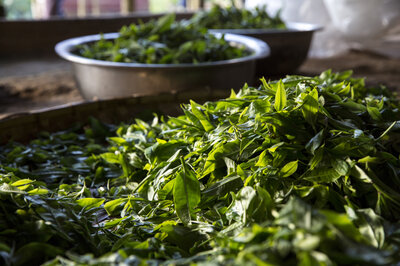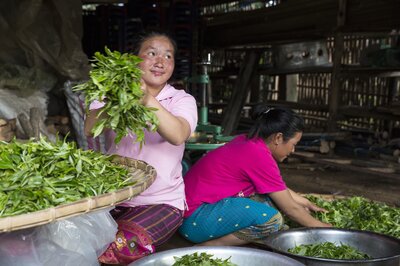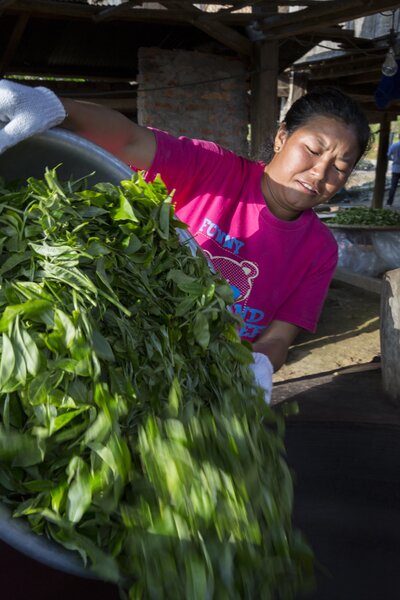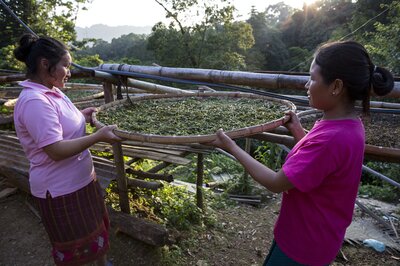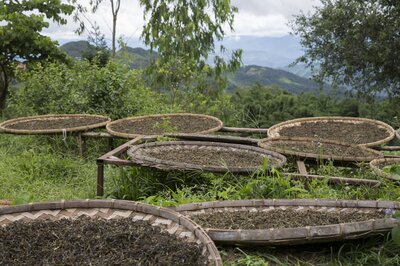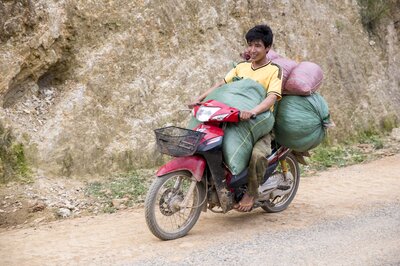The Tungs, a farming family in Laos
It’s a little after five in the morning in Ban Komaen, a little farming village in the province of Phongsaly in the far north of Laos. Most of the residents of this hard-to-reach village are still sleeping. But about twenty minutes’ walk away, up above the village center, the leaves are rustling in the trees. Sinchan, Bouvan and Khampao Tung are standing high up in the boughs, nimbly plucking the little bright green tea leaves from the branches. 51-year-old Khampao, Bouvan’s father and Sinchan’s father-in-law, says: We have to start working before the sun comes up and it gets too hot.
Tea usually grows on a bush. But here in the mountainous hinterlands of Phongsaly Province, it grows on trees. The trees are gnarled, with tortuously twisted branches. All told, there are supposed to be over 46,000 of them in Phongsaly. Some of them are over 400 years old, so they say in Ban Komaen. No one knows whether that’s really true, for many legends have grown up around these unique tea trees. Nor is it known for sure whether they grow wild or were planted by people a long time ago.
But the essential point is the extraordinary fact that tea grows on trees up here in the extreme north of Laos. Whether they’re a few years older or not is beside the point: the main thing is the quality of the tea leaves – and it’s excellent!
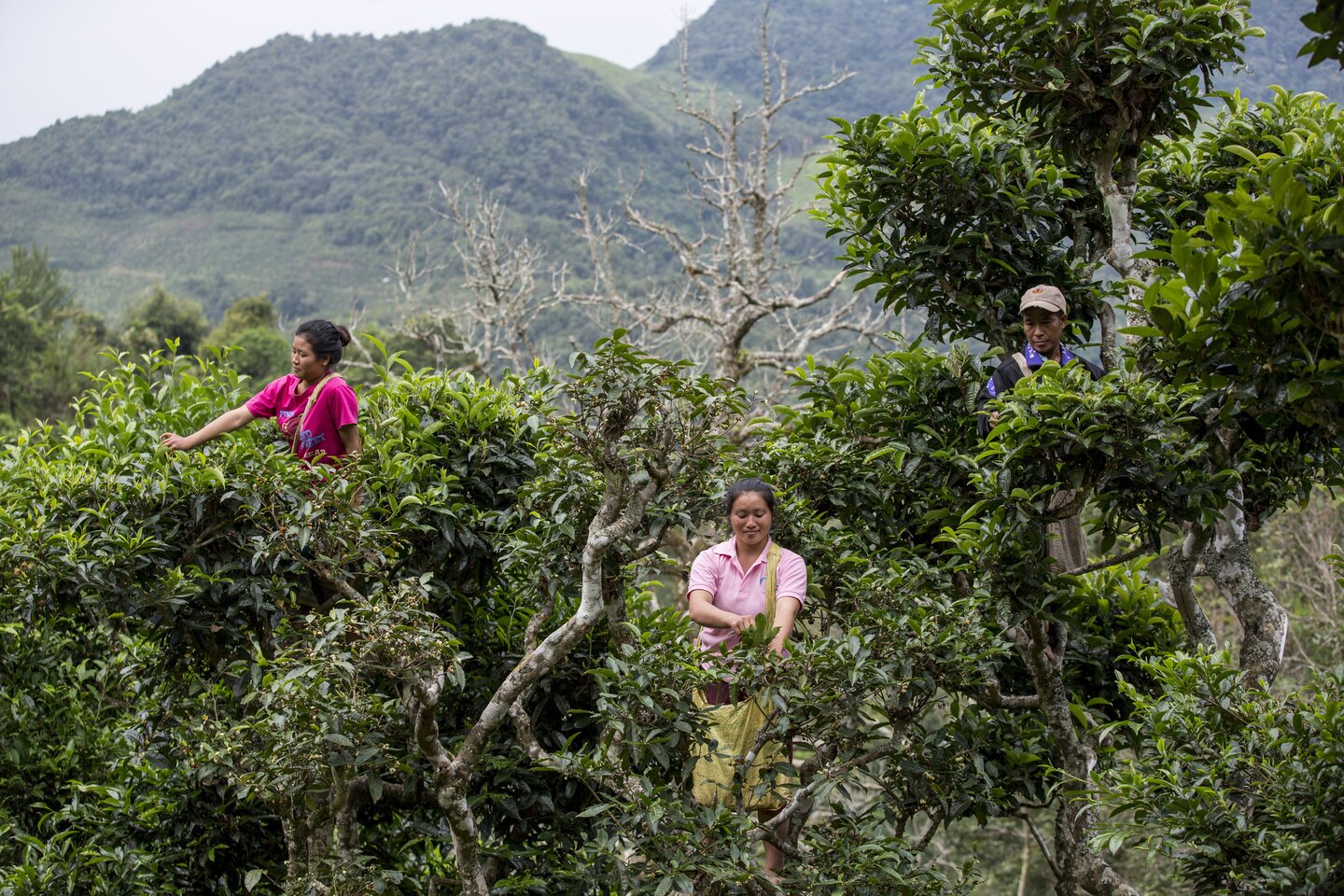
Phongsaly Province borders on Vietnam to the east and China to the west and north. The closest border crossing to China is only 80 km away, and Laos’ big neighbor also happens to be the biggest buyer of tea tree tea. Vientiane, the capital of Laos, is much harder to reach from here: farmers have to allow three days to drive there on the poorly planned roads, which are often closed on account of landslides during the rainy season.
Heavy dependency on China
As the principal buyers of tea tree tea, the Chinese dictate the prices, which vary considerably. The prices peak from February to May, when the weather is comparatively dry and the quality of the tea leaves very high. During this season, the farmers can earn up to 40,000 Lao kip per kg, roughly $5.
During the rainy season from late May to October, the price plummets to about 5,000 kip per kg, a little over 60 cents. A tea picker picks four to five kg of tea leaves a day on average, though as much as 10 to 15 kg on especially good days. In the dry season from November to January, when no tea leaves grow, most of the village farmers sell rice, which they also grow.
Tea farming is hard work. The whole Tung family pitches in. The family processes a small portion of the pickings themselves; the bulk of the harvest goes to a tea factory in the city of Phongsaly, the provincial capital, for processing.
The part of the harvest that is kept in the village is briefly heated up in the evening by 23-year-old Sinchan and her 21-year-old sister-in-law Bouvan in a deep metal bowl set in a stone hearth, which softens the leaves. Then the leaves are kneaded in a rolling drum. The juices are released in the process, fermentation begins and the leaves turn brown like a half-eaten apple. After this step, the two women lay the leaves out to dry in the evening sun in large flat baskets woven out of bamboo leaves. Bouvan’s husband, 28-year-old Thongxay Tung, fills up large sacks with the bulk of the crop. Then he takes them on his motorcycle to the factory about a half hour’s drive away. The Ban Komaen farmers’ tea is highly regarded in the factory.
Thongxay, 28 years old
The biggest tea factory in Laos
The leaves from the tea trees of Ban Komaen – and from bushes in other villages – are processed into tea, for the most part by hand, at the tea factory. Changtingyong Khampan’s tea factory is the largest in all of Laos. Six employees work here full time, and five or six more are on call. Many farmers from the environs bring their fresh pickings here. Two thirds of the tea processed at the factory goes to China, the rest stays in Laos.
The high-grade tea from Laos is not accorded great respect in China: it is usually used merely to enhance machine-harvested Chinese tea of inferior quality. This is one reason Changtingyong Khampan, the factor owner, is keen on tapping other foreign markets.
Changtingyong Khampan, factory owner
But it hasn’t come to that yet – and the tea farmers from Ban Komaen have two aces in the hole: Their tea is organic, a good selling point in China, where the tea is often laced with pesticides. And tea from 400-year-old trees is a very exclusive product whose quality is prized by the big neighbor.
Factory owner Khampan is content with the tea from Ban Komaen:
“The quality has further improved a great deal over the past few years.”
This is partly thanks to a Helvetas initiative whose goal, among other things, is to help 5,000 tea farmers in the Phongsaly region improve the quality of their produce and network with one another more effectively, e.g. at the annual World Fair Trade Day in Vientiane, the Laotian capital.
What is more, now he has only one contact to deal with, which makes negotiating a lot simpler. Though he adds with a smile, “Actually the negotiating is harder for me now because the farmers are stronger as a group.”
The improved quality of Ban Komaen tea, a strengthened and more self-confident farming community: the Helvetas project in the far north of Laos has achieved its goals.
Changtingyong Khampan, factory owner



